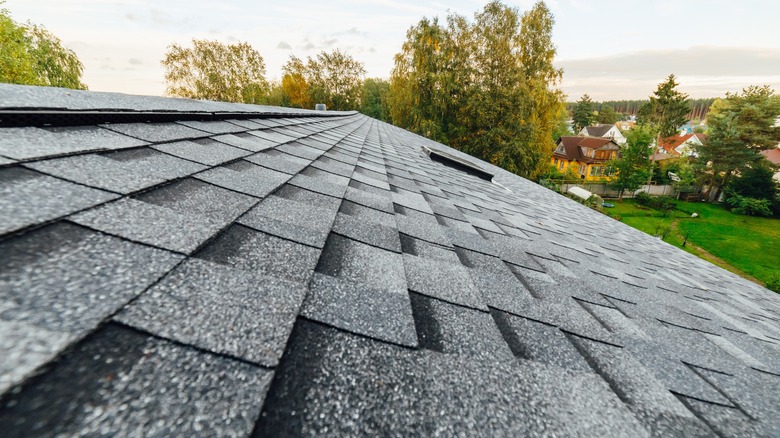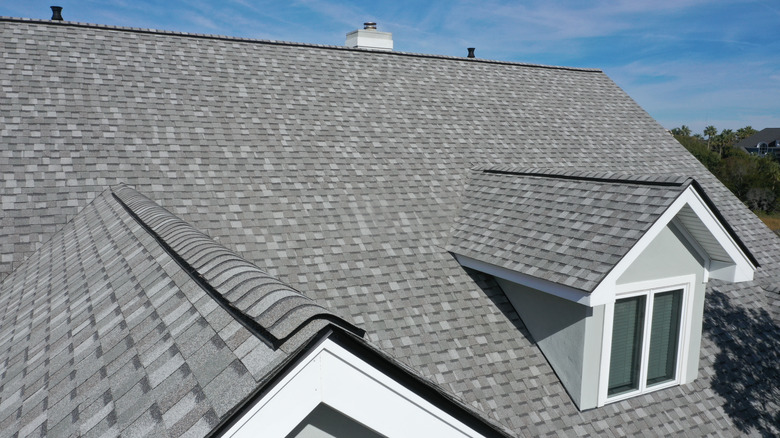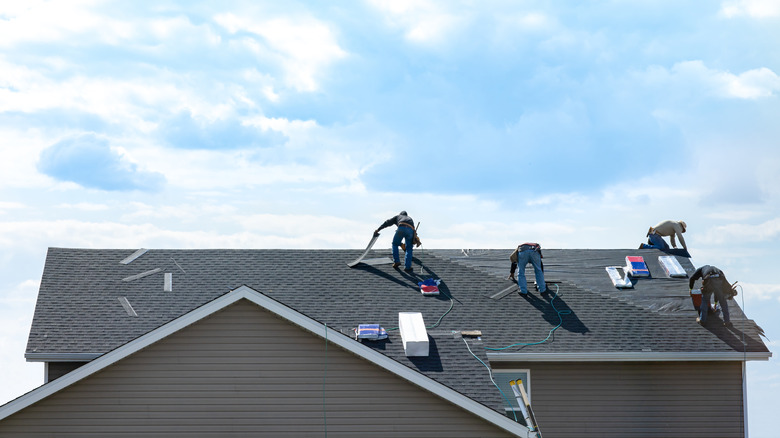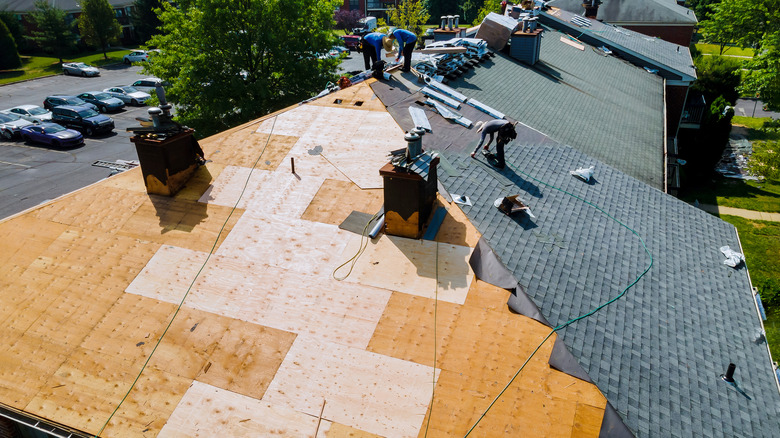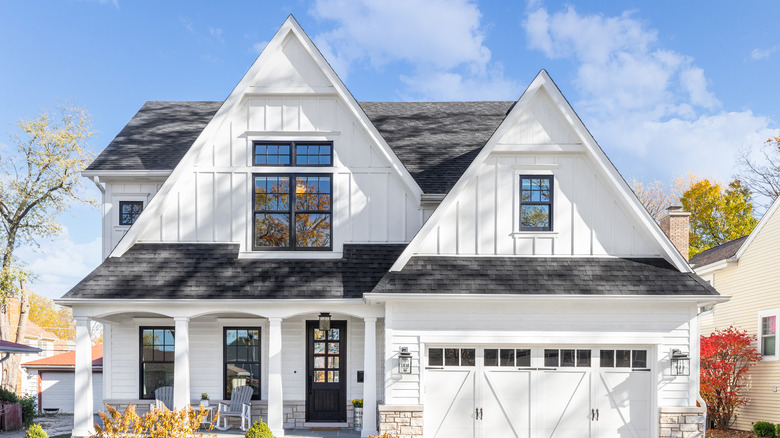Architectural Shingles Vs. 3-Tab Shingles: What's The Difference?
When replacing a roof, homeowners have many options to choose from. Today, homeowners can install metal roofing units that provide long term defense against the elements, they can opt for a tile roof that creates a unique aesthetic for the home, or make use of shingles that are flexible and look great. Shingles are a clear winner when it comes to refitting a roof in the United States (via Storm Master). U.S. homes are overwhelmingly built with shingle roofs, and homeowners often make use of asphalt shingles when installing a new roof regardless of whether this style was used in the initial construction or not.
But shingles come in many varieties, and even when considering an asphalt shingle roofing installation there is an important consideration to be made with regard to 3-tab shingles or architectural shingles. At first glance, the only difference might seem to be the way that these roofing elements layer on top of one another or sit next to each other. However, the decision to install an architectural shingle roof or a 3-tab shingle design is an important one that homeowners must carefully consider when refitting a new roof on their home.
Even though these two options are made of the same basic material, they provide completely different experiences for homeowners living beneath them. Continue reading to learn more about the differences between an architectural shingle and a 3-tab shingle roof.
Bottom line: 3-tab shingles are edged out by architectural shingles in many categories
When considering new shingle installation, the bottom line is that architectural shingles are simply the superior product over the 3-tab design. 3-tab shingles may fit better with the aesthetic priorities of specific homeowners, but structurally they are no match for the value and longevity that architectural shingles provide to a home (via Findlay Roofing). Architectural shingles are heavier than the 3-tab option and may not be a good choice for installation on older structures that might require augmentation to support the additional weight. However, most modern homes won't have a problem when it comes to selecting this type of shingle design over a cheaper variety that might come with a lighter weight load.
Architectural shingles have become the standard in new home construction, and for good reason. These shingles are just better than other asphalt or other roofing shingle options. Of course, if you are interested in discussing the use of an alternative to architectural shingles then it's important to voice these concerns with your roofing contractor and browse through alternatives available in your area. Not all homeowners will need the additional durability and strength of an architectural shingle, so this conversation should be had by just about any homeowner regardless of where you live or the type of property that you call home.
Both options are built as an asphalt shingle and are very popular
Shingles are by far the most popular option when it comes to building new homes or reroofing existing properties that require replacement. As noted, shingles account for around 80% of all home roofs in the United States. Shingles are cost-effective and typically simple to install. But there are a few different types of shingles that homeowners must make themselves aware of in order to select the best option for their unique circumstances. Modernize reports that 18 different types of shingles are commonplace in the American market, and each option provides its own benefits and potential drawbacks.
Overall, asphalt shingle construction dominates the market. They are long-lasting and durable in the face of extreme weather conditions, and they are a cost-effective installation since they're lightweight and fairly easy to install. Both the 3-tab shingle and architectural shingle are built from an asphalt blueprint, but their weight and installation process vary as a result of other aspects of their fabrication processes. For one thing, architectural shingles are roughly three times as heavy as the 3-tab variety. This makes them far more durable than the lighter option, but not every home will have the capability of supporting this added weight without the addition of other costly renovation inclusions.
Whether you're thinking of purchasing the more expensive and heavier architectural shingle design or making use of a more budget-friendly 3-tab option, you can rest assured that the asphalt shingle construction of either addition is high quality and will give you many years of protection from the elements.
Installation costs are lower on 3-tab shingles
The installation costs associated with the 3-tab shingle design are typically dramatically lower than that of architectural shingles. This comes as a result of the lighter material, making it easier to manipulate the sheets and tap them into place (via Remodeling Costs). However, it should be noted that the installation pattern and lighter material layout of 3-tab shingles make them more prone to breakage over the course of the many years they will be sitting on top of your home. This translates into greater repair costs on average than homeowners who install architectural shingles will likely see. The tradeoff between low installation cost and low maintenance cost is an important one.
It's always a good idea to discuss these and other options with a number of different contractors before making a decision on who will install your new roof and what type of material they will use to complete the job. While different types of shingles will be quoted differently, contractors may not price their installation processes the same, leading to a reduction in upgraded material by one roofer over the others you speak with.
Angi suggests sourcing at least three quotes for any home improvement project you may be considering. Speaking with roofers will give you a better sense of the availability of materials and timeline for completion. As well, a roofing contractor will be able to tell you more information about which type of shingle construction option is better for your local area. Differences are distinct between architectural and 3-tab shingles, but they are definitive. An area that sees heavy snowfall, for instance, may benefit from a lighter shingle construction that won't threaten to bring the roof down when the first blizzard of the year places a huge additional burden on the roof structure. Alternatively, more durable roofing installations may be required in areas that see high wind on a regular basis, such as the southeast (during Atlantic hurricane season), or the Midwest, which deals with tornadoes on a routine basis.
Maintenance can be more demanding for a 3-tab roof, however
As noted earlier, maintenance requirements are more pronounced with a 3-tab roof construction. The shingles in a 3-tab roof overlap with one another, creating a unique wavy pattern across the roof. Some homeowners might prefer this look, but they likely won't prefer the additional maintenance requirements that come along with this type of installation. Home Advisor reports that 3-tab shingles make use of thinner asphalt construction, while architectural shingles have a secondary layer and a larger volume of asphalt grains across their surface area. This makes architectural shingles far better at withstanding the elements.
Maintenance on a 3-tab roof is more demanding because of the lighter weight and lower wind rating associated with this type of construction. This type of shingle can lift and tear away much easier than an architectural shingle. This means that you'll likely need to maintain a reserve of shingle material and check the roof for problems on a more regular basis.
It is already well established that homeowners should investigate the health of their roof at least twice a year (via Roof Revivers). Climbing up on the roof every six months allows you to inspect this critical asset between turning seasonal temperature changes. In practice, this means that you'll see the state of the roof directly before and directly after the cold has set in across your local area. Alternatively, a homeowner could inspect the roof in the dead of winter and then at the height of summer's peak heat. No matter how you schedule your roof inspections, viewing the state of your shingles every six months will help you identify problem areas and flaws in the material that are exacerbated by changing temperatures and the features that come with this shift, like humidity, greater or fewer sunlight hours, and moisture changes in the form of rain or snow.
Wind rating can create a demand for certain installations based on your location
Architectural shingles do a much better job of standing up to heavy wind conditions than 3-tab shingle construction. Architectural shingles are built to withstand sustained winds at 80 mph, and some varieties can even bring this rating up to 130 mph (via Victors Roofing). Three-tab shingles, on the other hand, are typically rated for a maximum durability standard of about 60 miles an hour. This means that they are a great option for homes that don't experience strong wind conditions on a regular basis. Homeowners in Florida are intimately familiar with this difference in wind defense, with hurricane season arriving every year in the summer and bringing a handful of storms to both Atlantic and Gulf coast shores reliably each year.
Wind ratings can play a major role in your decision to use one type of shingle or another. Some communities simply require this additional level of protection, so architectural shingles are really the only viable avenue when pursuing a roof replacement. Of course, this all comes down to your unique circumstances and the needs of your property and local community. Similarly, an older home in a hurricane or tornado-prone area might benefit from enhanced wind protection in the classical sense, but in reality, an upgraded roofing material won't matter if the building itself isn't still capable of withstanding hurricane-force winds. Your roofing contractor is the best resource for information on which type of shingle is best for your specific needs and property type, so speaking with this team is always a good idea when selecting the type of roof replacement that will work best for your budget and localized requirements.
Architectural shingles often last much longer
Another difference can be found in the lifespan of each type of shingle. Architectural shingles will perform better in all types of weather conditions, including high winds, snowy climates, and areas that see extreme heat or significant rainfall. As a result, architectural shingles will last slightly longer than the average of about 25 years for a typical roof. Architectural shingles will last roughly 20 years if exposed to a routine excess of weather conditions and about 30 with good luck in the weather department (via Roof Calc). Similarly, 3-tab shingles can expect to last perhaps 15 to 20 years in a favorable mix of weather conditions with a reduction down to about 10 years if the roof is continuously battered by extended periods of bad weather.
Because of the cost to get a new roof, it's worth thinking about the lifespan that any particular type of installation can provide to you and your home. Of course, the longer a roof remains viable the longer you have to save and plan for the next installation. Alternatively, some homeowners will remain in their property for multiple roof replacements while others live in a property for the lifespan of a single roof and never see this requirement comes to fruition. The National Association of Realtors notes that the average homeowner remains in their property for about 13 years before moving on to a new home that better suits their evolving needs. And so an intimate understanding of your own particular experience as a homeowner can help determine whether you will get a better value with a more expensive and longer-lived roofing shingle option or one that provides you with a reduction in price.
Warranty offers can differ greatly as well
Warranty policies on these two separate shingle types can vary greatly. Just like the construction approach and installation processes are unique to these two types of shingle options, homeowners can expect to see different warranty lengths and coverage terms depending on the type of roof they have installed on their property. For one thing, architectural shingles last longer and so therefore the warranty that comes with these roof installations will extend beyond that of a 3-tab shingle roof. This offers a high-quality level of protection for a homeowner looking to get the most out of their home. A longer warranty is always a beneficial thing, especially in locations that see dramatic changes in weather and a distinct level of uncertainty. Unfortunately, the world is a changing place and wildfires in the Pacific Northwest, hurricane season along the Atlantic and gulf coasts, and blizzard, wind, and tornado conditions that persist throughout middle America and the north can place a home and its roof in jeopardy throughout the year (via U.S. Environmental Protection Agency). Therefore, a longer warranty is often a beneficial addition to any type of product that will see intimate exposure to the elements.
Architectural shingles have a clear edge in this regard, and so the added expense may be worth it to some homeowners who want to incorporate this additional level of protection. In fact, Roofing Above All notes that some architectural shingles may come with a lifetime warranty meaning that environmental damage can be completely stress-free for the homeowner.
There is a caveat here that should be mentioned, however. Warranty coverage is typically incorporated in products like roofing installations to protect the homeowner against faulty installation or poor-quality building material that may have slipped through the quality control process. As a result, these issues are likely to be felt early on in the life of your new roof. Therefore, warranty coverage in this regard may only really need to extend for a few months or perhaps a year or two at the most. After this point, there is virtually no risk of a fault occurring because of poor installation processes or structural failures within the building materials themselves. This means that a short warranty may be more beneficial than paying for a standalone or built-in coverage policy with an extended timeline that might not be very useful beyond the early stages following an installation.
Aesthetics are subjective, and these shingles provide starkly different looks
Aesthetics are a completely subjective component in home design and shingle construction. One thing that can't be accounted for is personal style and preference when evaluating the differences between 3-tab shingles and architectural shingles (or any other roof construction material and method for that matter).
The 3-tab construction options sees your shingles situated on top of each other in a wavy format (via Sol Vista Roofing), whereas an architectural shingle roof will sit flat with brick-like shapes dominating the roof space in uniform. These looks are drastically different, and your own personal preference might dictate the installation of one visual layout over another. One thing that might help you understand where your head and heart might lead is in your preference for modern versus vintage styles. The 3-tab shingle was the dominant construction style on roofs across the United States until the 1980s. As a result, architectural shingles can be seen on newer roofs and more modern household styles. If you are a big fan of vintage home design and old-style construction techniques, then a 3-tab shingle construction might be the perfect option for you, granted your local community weather patterns can reasonably support this choice.
